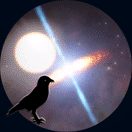|
Extremely Habitable System
|
|
| Three1415 | Date: Monday, 06.04.2015, 07:31 | Message # 1 |
|
Observer
Group: Newbies
 United States
United States
Messages: 1
Status: Offline
| As is probably determinable from the title, I have come to share the single most awesome system I have found to date. Not only does it have five planets/moons with an ESI greater than 0.79, it also possesses some of the best views I have yet discovered in SE.
For starters, the system has an optimal location within Hoag's Object (a strange yet beautiful ring galaxy), as it is positioned on the inner edge of the torus, leaving it with a completely unimpeded view of the majority of the galaxy:

The system has something of an unremarkable single star, an asteroid belt, some dwarf planets, etc. However, its primary highlight is a rare phenomenon, something I have seen only once: A pair of binary terras.

The planet, which supports life, has an ESI of 0.938; it would be extremely Earthlike were it not for its rather low atmospheric pressure (only a seventh of that at Earth's surface), and, doubtless for that same reason, it has multicellular life only in its expansive oceans.

Its moon is, strangely, probably the more habitable of the pair, despite the fact that is has an ESI of only 0.871; although it is mostly desert and is barren of life, it possesses a sufficiently thick atmosphere to support human habitation without any additional life support.

Additionally, a nearby gas giant sports three oceanias in consecutive orbits; intriguingly, they have red, green, and blue seas, respectively, and none has an ESI lower than 0.79. They make for quite a sight in orbit (The below image is taken from the outermost one):

And, finally, for the strangest bit:

A true easter egg, flying through space. No, this is not a custom system. But no, this should not be possible in SE; somehow, the extraordinarily close dwarf moon has persuaded the engine that its semi-major axis is nearly three times its actual value, which is enough to put it outside the dwarf planet's Roche limit. Its actual semi-major axis is something closer to 540 km, which is absurdly close, especially given that the asteroid is 188 kilometers in diameter; additionally, it orbits so low and so fast that its movement across the sky is discernible even at 1x speed, which is incredibly disconcerting to the eye.
All in all, a weird but wonderful system.
|
| |
| |
| ElectricalEel | Date: Monday, 06.04.2015, 18:09 | Message # 2 |
 Space Tourist
Group: Users
 Kuwait
Kuwait
Messages: 33
Status: Offline
| Wouldnt its location close to the center of the galaxy be quite dangerous? because most supernovas and gamma ray bursts happen there
oh and wouldnt a moon that big relative to its planet cause extreme volcanism and tides?
edit:added the above question
Edited by ElectricalEel - Monday, 06.04.2015, 18:19 |
| |
| |
| Tangle10 | Date: Friday, 10.04.2015, 21:58 | Message # 3 |
 Space Pilot
Group: Users
 United States
United States
Messages: 129
Status: Offline
| Quote ElectricalEel (  ) Wouldnt its location close to the center of the galaxy be quite dangerous? because most supernovas and gamma ray bursts happen there
oh and wouldnt a moon that big relative to its planet cause extreme volcanism and tides?
It's not close to the centre of the galaxy... Hoag's object is 30.6kpc in size, while the Milky Way is 38.6 kpc. The system's distance from the core is about 7 kpc. Sol's distance is anywhere from 7.5 kpc to 8.5 kpc (in the game it's 8.5, but I prefer about 8). Using a proportion, this means our new system's distance, to be equivalent to Sol's distance from the Milky Way core according to SE, would be 6.7 kpc. I can't find this system in in SE, but its distance is around 7 kpc- so this system is FURTHER away than Sol's equivalent position.
Also probably for the tides, but that's why it's tidally locked and a couplet world.
I wouldn't say extremely habitable though...
Tips for finding Earth-Like planets: Look for F, G, or K Class stars. M class habitables will almost always be tidelocked. Oceanias can, of course, also be habitable, they just have tiny amounts of land.
|
| |
| |
| ElectricalEel | Date: Saturday, 11.04.2015, 03:54 | Message # 4 |
 Space Tourist
Group: Users
 Kuwait
Kuwait
Messages: 33
Status: Offline
| Quote ElectricalEel (  ) It's not close to the centre of the galaxy... Hoag's object is 30.6kpc in size, while the Milky Way is 38.6 kpc. The system's distance from the core is about 7 kpc. Sol's distance is anywhere from 7.5 kpc to 8.5 kpc (in the game it's 8.5, but I prefer about 8). Using a proportion, this means our new system's distance, to be equivalent to Sol's distance from the Milky Way core according to SE, would be 6.7 kpc. I can't find this system in in SE, but its distance is around 7 kpc- so this system is FURTHER away than Sol's equivalent position.
huh, i thought it looked pretty close to the center from the picture,unless space engine doesnt draw galaxies to scale
|
| |
| |
| storminator54 | Date: Monday, 18.01.2016, 14:16 | Message # 5 |
|
Observer
Group: Newbies
 Pirate
Pirate
Messages: 1
Status: Offline
| Well this is very strange- copied the exact coordinates of the star and somehow its a completely different system! No habitable planets, despite it being the same Galaxy. Maybe something changed in an update
|
| |
| |
| JackDole | Date: Monday, 18.01.2016, 14:38 | Message # 6 |
 Star Engineer
Group: Local Moderators
 Germany
Germany
Messages: 1742
Status: Offline
| Quote storminator54 (  ) Well this is very strange- copied the exact coordinates of the star and somehow its a completely different system! No habitable planets, despite it being the same Galaxy. Maybe something changed in an update
This happens with any update that Star systems are changing, or even no longer exist.
Don't forget to look here.

|
| |
| |